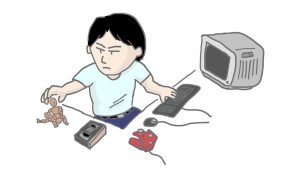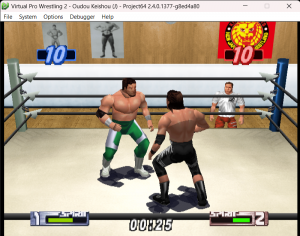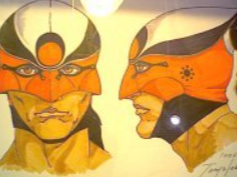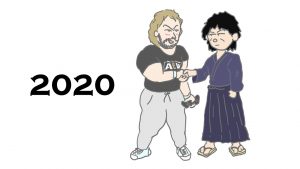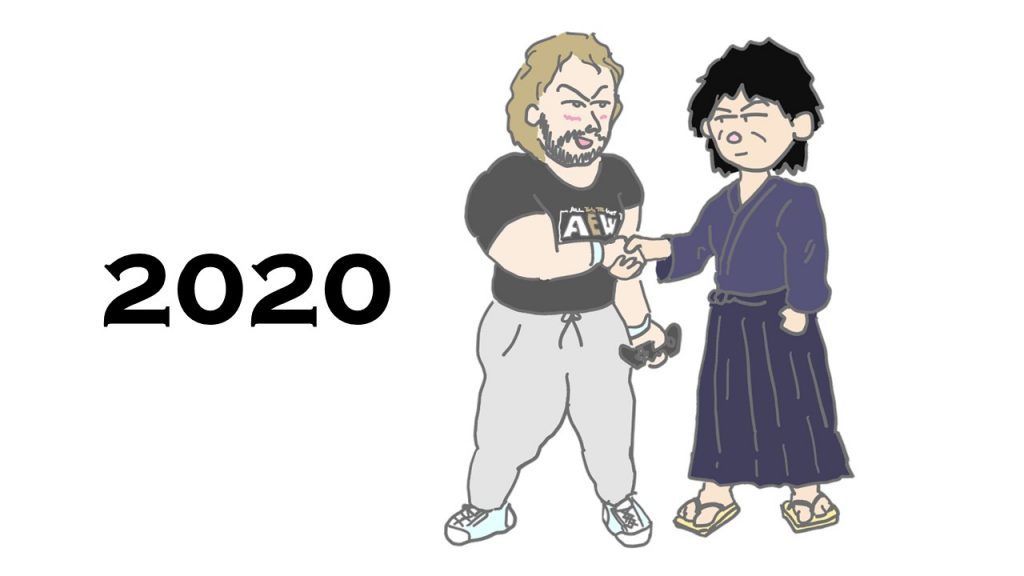
Editor’s Note: This is a translation of Hideyuki “Geta” Iwashita’s blog. Geta-san was the Director of the AKI wrestling games including WCW/nWo Revenge, WWF No Mercy and Virtual Pro Wrestling 1+2, and is also a consultant on the AEW “Fight Forever” game. All copyright and intellectual property rights in the underlying Japanese text (and the drawings) rests with Geta-san as the original creator.
Original blog is here: 第一夜『選ばれし者の恍惚と不安』 (geta-pro.jp)
A candle in the wind
It’s been a long time since the light of pro-wrestling games has disappeared from the Japanese game market. Saying such a thing might get me scolded, like “Aren’t there various smartphone games available?!”, but in my opinion, those are “card games” and not the pro-wrestling games I’m talking about here.
“Whether it’s the royal road or the evil path, it’s all pro-wrestling!” Whether someone said it or not, of course, there can be various types of pro-wrestling games. However, our attempts to recreate “those” heart-throbbing, soul-shaking pro-wrestling scenes were made through action-packed pro-wrestling games, in which wrestlers could be controlled in 2D and 3D expressions.
And the fact that the light has gone out means that the light of pro-wrestling itself, the source of this demand, has also gone out. No… that shouldn’t be the case. In the new coronavirus crisis that started in 2020, as many as 14,000 fans gathered as spectators at the Tokyo Dome in January 2021. The light of pro-wrestling has not gone out.
Furthermore, this light is not just about the current movement, but is also continuously shining through countless memorable scenes and famous wrestlers from the past. I want to believe that.
Fate’s mischief
At times… I am a die-hard pro wrestling fan who has lived through a quarter-century of wrestling’s golden age, and, fortunately, along the way, I became the director of the “Virtual Pro Wrestling” game series as “Geta-san.”
Unfortunately, I have been away from the pro wrestling game development scene for several decades and have been in a semi-retired state. However, I never declared retirement. I just couldn’t find a worthy opponent or a ring to climb. Then, as if fate was playing a trick on me, I received a sudden and unexpected request directly from Kenny Omega, the top wrestler and executive vice president of the newly established AEW in America last year. I was appointed as the development supervisor for the new AEW game.
This is something that pro wrestling game fans worldwide probably already know, so I won’t talk about it too much. When I received this offer, I was so shocked and it felt like a dream come true that I couldn’t help but pinch my cheek at my own fortune. Kenny’s own pro wrestling game flame continued to burn, and it was as if he passed the torch to the flame inside me, fueling it even more.
A bolt from the blue
He, Kenny Omega, found and chose me for a reason. It’s because he’s a huge game fan, as most fans know, and he used to play games like “WrestleMania 2000” and “No Mercy” on the Nintendo 64 with great joy before he even became a professional wrestler.
These two games were essentially adaptations of the “Virtual Pro Wrestling” series I worked on in Japan, featuring then world’s number one popular WWE (at the time: WWF) superstars and arenas. Fans of these games at the time, including Kenny, probably never dreamed that people from a small island nation in the Far East were developing American major league wrestling games.
Of course, there were also American wrestling games developed by companies like Acclaim, which held WWF rights at the time. However, for some reason, these two games quickly surpassed them in sales and fans. The game mechanics, originally built around the Japanese wrestling scene I had been watching since childhood, were strangely well-received by American wrestling fans as well.
This was truly astonishing. To give you an idea, it’s like if a Japanese baseball game were developed by Americans who studied the sport and then became a huge hit in Japan. If you think about it like that, you can understand how unusual or exceptional this was.
So, we readily prepared to meet these demands without any opposition and simply built the game with a strong Japanese wrestling spirit. The producer at the time, although knowledgeable about wrestling, basically agreed with me and my team 100% and supported us. I guess we were lucky in that regard. When he did give input, it was limited to personal preferences like, “Make this move look cooler” or “Change this superstar’s move to this one.”
Furthermore, I think the limitations of 3D hardware expression and the cheapness of visuals at the time also pushed us forward. We created a game almost “freely” and it was embraced by fans around the world with great empathy, including Kenny Omega, who would later become a prominent wrestler in the industry. It’s like a miraculous coincidence.
You’ll know when you get there
Was it the result of adding an American twist to the pro-wrestling game we developed in Japan? Was it the fruit of our careful consideration and efforts to make it palatable to an American audience? No, I must confess that wasn’t the case at all.
Of course, being an official game of the WWF, there were naturally various requirements regarding the superstars, arenas, move animations, and costume details. However, those were merely like “wrapping paper” for the product. As long as it was presented with the WWF branding and met the basic criteria, it was sufficient.
Now, as I work with him and look back at myself, I can’t help but feel the incredible fortune of this once-in-a-lifetime opportunity.
